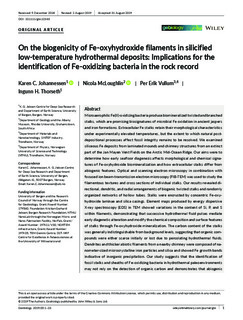| dc.contributor.author | Johannessen, Karen Cecilie | |
| dc.contributor.author | McLoughlin, Nicola | |
| dc.contributor.author | Vullum, Per Erik | |
| dc.contributor.author | Thorseth, Ingunn Hindenes | |
| dc.date.accessioned | 2019-12-10T07:27:30Z | |
| dc.date.available | 2019-12-10T07:27:30Z | |
| dc.date.created | 2019-11-17T12:31:15Z | |
| dc.date.issued | 2019 | |
| dc.identifier.citation | Geobiology. 2019, 1-23. | nb_NO |
| dc.identifier.issn | 1472-4677 | |
| dc.identifier.uri | http://hdl.handle.net/11250/2632364 | |
| dc.description.abstract | Microaerophilic Fe(II)‐oxidizing bacteria produce biomineralized twisted and branched stalks, which are promising biosignatures of microbial Fe oxidation in ancient jaspers and iron formations. Extracellular Fe stalks retain their morphological characteristics under experimentally elevated temperatures, but the extent to which natural post‐depositional processes affect fossil integrity remains to be resolved. We examined siliceous Fe deposits from laminated mounds and chimney structures from an extinct part of the Jan Mayen Vent Fields on the Arctic Mid‐Ocean Ridge. Our aims were to determine how early seafloor diagenesis affects morphological and chemical signatures of Fe‐oxyhydroxide biomineralization and how extracellular stalks differ from abiogenic features. Optical and scanning electron microscopy in combination with focused ion beam‐transmission electron microscopy (FIB‐TEM) was used to study the filamentous textures and cross sections of individual stalks. Our results revealed directional, dendritic, and radial arrangements of biogenic twisted stalks and randomly organized networks of hollow tubes. Stalks were encrusted by concentric Fe‐oxyhydroxide laminae and silica casings. Element maps produced by energy dispersive X‐ray spectroscopy (EDS) in TEM showed variations in the content of Si, P, and S within filaments, demonstrating that successive hydrothermal fluid pulses mediate early diagenetic alteration and modify the chemical composition and surface features of stalks through Fe‐oxyhydroxide mineralization. The carbon content of the stalks was generally indistinguishable from background levels, suggesting that organic compounds were either scarce initially or lost due to percolating hydrothermal fluids. Dendrites and thicker abiotic filaments from a nearby chimney were composed of nanometer‐sized microcrystalline iron particles and silica and showed Fe growth bands indicative of inorganic precipitation. Our study suggests that the identification of fossil stalks and sheaths of Fe‐oxidizing bacteria in hydrothermal paleoenvironments may not rely on the detection of organic carbon and demonstrates that abiogenic filaments differ from stalks and sheaths of Fe‐oxidizing bacteria with respect to width distribution, ultrastructure, and textural context. | nb_NO |
| dc.language.iso | eng | nb_NO |
| dc.publisher | Wiley | nb_NO |
| dc.rights | Navngivelse 4.0 Internasjonal | * |
| dc.rights.uri | http://creativecommons.org/licenses/by/4.0/deed.no | * |
| dc.title | On the biogenicity of Fe-oxyhydroxide filaments in silicified low-temperature hydrothermal deposits: Implications for the identification of Fe-oxidizing bacteria in the rock record | nb_NO |
| dc.type | Journal article | nb_NO |
| dc.type | Peer reviewed | nb_NO |
| dc.description.version | publishedVersion | nb_NO |
| dc.source.pagenumber | 1-23 | nb_NO |
| dc.source.journal | Geobiology | nb_NO |
| dc.identifier.doi | 10.1111/gbi.12363 | |
| dc.identifier.cristin | 1748371 | |
| dc.relation.project | NORTEM: 197405 | nb_NO |
| dc.relation.project | Norges forskningsråd: 179560 | nb_NO |
| dc.description.localcode | © 2019 The Authors. Geobiology published by John Wiley & Sons Ltd. This is an open access article under the terms of the Creative Commons Attribution License, which permits use, distribution and reproduction in any medium, provided the original work is properly cited. | nb_NO |
| cristin.unitcode | 194,66,20,0 | |
| cristin.unitname | Institutt for fysikk | |
| cristin.ispublished | true | |
| cristin.fulltext | original | |
| cristin.qualitycode | 1 | |

